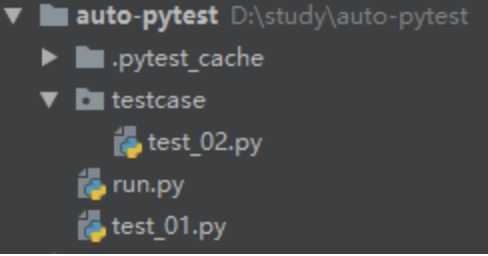使用下面的参数可以让测试在第1(N)次测试失败后停止:
pytest ‐x # 第一次测试失败后停止测试
pytest ‐‐maxfail=2 # 第2次测试失败后停止测试
修改文件如下
# filename:test_02.py import pytest class TestDemo02: def func(self, x): return x + 1 # 修改成断言失败 def test_01(self): assert self.func(3) == 14 # 修改成断言失败 def test_02(self): assert self.func(3) == 5 if __name__ == ‘__main__‘: pytest.main([‘-s‘, ‘-x‘, ‘test_02.py‘])
运行后观察结果
test_02.py F ================================== FAILURES =================================== _____________________________ TestDemo02.test_01 ______________________________ ...此处省略报错具体原因 test_02.py:10: AssertionError =========================== short test summary info =========================== FAILED test_02.py::TestDemo02::test_01 - assert 4 == 14 !!!!!!!!!!!!!!!!!!!!!!!!!! stopping after 1 failures !!!!!!!!!!!!!!!!!!!!!!!!!! ============================== 1 failed in 0.09s ============================== Process finished with exit code 0
可以看出,由于第一条报错,2条用例只执行了第1条,使用‐‐maxfail=2可以失败两次后停止,大家自己尝试下。
通过test_01.py文件执行测试
pytest test_01.py
通过文件夹执行测试
pytest testcase
创建testcase目录,然后把test_02.py移入目录下,就像这样

然后执行命令,可以发现只执行了test_02.py下的用例
============================= test session starts ============================= platform win32 -- Python 3.7.1, pytest-6.0.2, py-1.9.0, pluggy-0.13.1 rootdir: D:\study\auto-pytest collected 3 items testcase\test_02.py FF ================================== FAILURES =================================== _____________________________ TestDemo02.test_01 ______________________________ ...此处省略报错具体原因 testcase\test_02.py:11: AssertionError _____________________________ TestDemo02.test_02 ______________________________ ...此处省略报错具体原因 testcase\test_02.py:15: AssertionError =========================== short test summary info =========================== FAILED testcase/test_02.py::TestDemo02::test_01 - assert 4 == 14 FAILED testcase/test_02.py::TestDemo02::test_02 - assert 4 == 5 !!!!!!!!!!!!!!!!!!!!!!!!!! stopping after 2 failures !!!!!!!!!!!!!!!!!!!!!!!!!! ============================== 2 failed in 0.04s ==============================
通过关键字表达式来进行测试
这种方式会执行文件名,类名以及函数名与给定的字符串表达式相匹配的测试用例。
pytest ‐k "Demo02 and not 01"
上面的用例会执 行TestDemo02.test_02但是不会执行TestDemo02.test_01,就像这样,另外3个没执行
============================= test session starts ============================= platform win32 -- Python 3.7.1, pytest-6.0.2, py-1.9.0, pluggy-0.13.1 rootdir: D:\study\auto-pytest collected 5 items / 3 deselected / 2 selected testcase\test_02.py .. ======================= 2 passed, 3 deselected in 0.03s =======================
通过节点id来进行测试
参数化的类名、函数名和参数,用::分隔。
可以通过下面的方式运行模块中的指定的测试用例
pytest testcase/test_02.py::TestDemo02:test_01
可以从结果看出,执行了test_02.py内TestDemo02类下的test_01方法
============================= test session starts ============================= platform win32 -- Python 3.7.1, pytest-6.0.2, py-1.9.0, pluggy-0.13.1 rootdir: D:\study\auto-pytest collected 1 item testcase\test_02.py . ============================== 1 passed in 0.01s ==============================
通过标记来执行
pytest ‐m tag01
这种方式会运行所有通过装饰器 @pytest.mark.tag进行装饰的测试用例,所以我们来修改test_02.py文件
# filename:test_02.py import pytest class TestDemo02(): def func(self, x): return x + 1 @pytest.mark.tag01 def test_01(self): assert self.func(3) == 4 def test_02(self): assert self.func(3) == 4 def test_03(self): assert self.func(3) == 4
修改后,运行得到结果,可以看出只执行了打上标记的用例,篇幅问题,结果就不贴上来了
也可以通过pytest -m "tag01 or tag02"来执行标记为tag01和tag02的用例
原文:https://www.cnblogs.com/easy-test/p/13737604.html